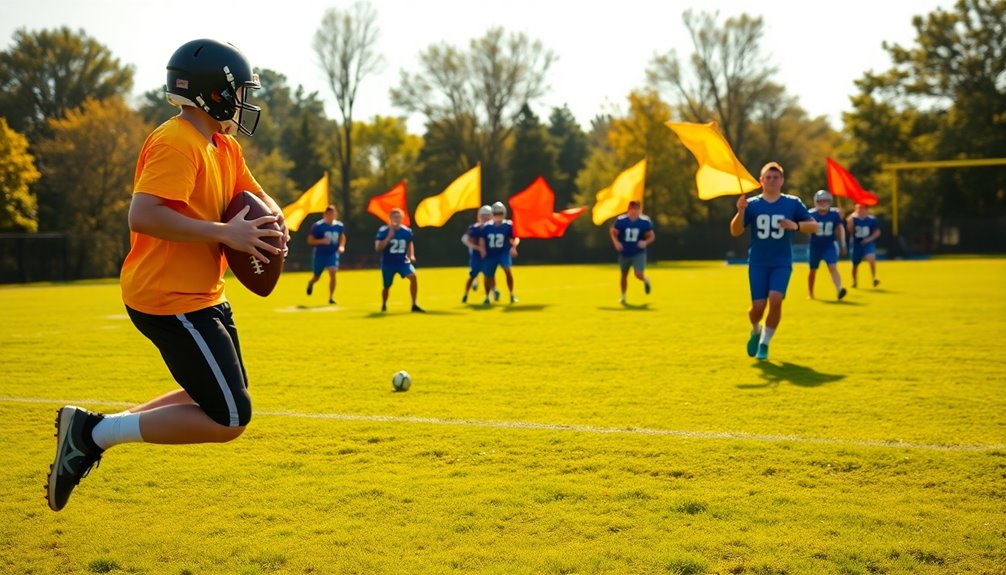
Key Positions in Flag Football Explained for Beginners
January 8, 2025In flag football, knowing the key positions can enhance your gameplay. The quarterback leads the offense, making quick decisions after receiving the snap. The center snaps the ball and provides protection. Wide receivers run specific routes to catch passes, while running backs receive handoffs and aim to evade defenders. On defense, defensive backs pull flags to stop plays. Each role is essential for team success, emphasizing communication and strategy. By understanding these positions, you'll be better prepared to enjoy the game to the fullest and discover even more insights about gameplay dynamics.
Overview of Flag Football Positions
In flag football, understanding the key positions on the field can give you a significant advantage. The Quarterback is the central figure in the offense. They receive the snap and decide whether to pass or hand off the ball, but they can't run after the snap. This makes their decision-making essential, as they must read the defense quickly to make effective plays. A strong understanding of defensive strategies can further enhance the quarterback's ability to exploit weaknesses in the opposing team.
The Center plays an important role by snapping the ball to the quarterback to initiate the play. They can also act as a receiver, adding an extra layer to the offense that's often overlooked.
Wide Receivers are your go-to players for catching passes. They run defined routes and need to create separation from defenders with their agility and good hands, often relying on effective teamwork to execute successful plays.
Meanwhile, Running Backs receive handoffs from the quarterback. Their agility and ability to perform moves like jukes help them evade defenders and advance the ball effectively.
On the defensive side, Defensive Backs focus on stopping offensive plays. They pull flags from ball carriers, requiring quick reflexes and anticipation skills to effectively counter the offense. Maintaining proper spacing is crucial for defensive alignment and can significantly impact the effectiveness of your defense.
Knowing these positions and their roles can help you strategize better on the field.
Understanding Offensive Roles
Understanding offensive roles in flag football is essential for maximizing your team's performance on the field. The quarterback is the focal point of the offense, receiving the snap and making quick decisions to either pass or hand off the ball. However, remember that in flag football, they can't run with it after the snap. The quarterback's decision-making can greatly influence the game's outcome, similar to the way team captains lead communication in soccer. A strong decision-making process can help the quarterback effectively read the defense and choose the best play.
The center plays a critical role too, snapping the ball to the quarterback and immediately becoming an active receiver, which can catch defenders off guard.
Next, you have the wide receivers, whose job is to run defined routes to get open for passes. They need good hands and often height to secure those catches from the quarterback.
Meanwhile, running backs are important for advancing the ball downfield; they receive handoffs and rely on their agility to dodge defenders with effective spin moves or jukes.
Typically, an offensive team consists of one quarterback, one center, and several wide receivers and running backs. This combination creates a balanced attack, allowing your team to utilize various strategies and keep the defense guessing.
Understanding these roles can greatly enhance your team's effectiveness on the field. Additionally, effective communication with teammates is crucial for coordinating plays and ensuring seamless execution during games.
The Quarterback's Responsibilities
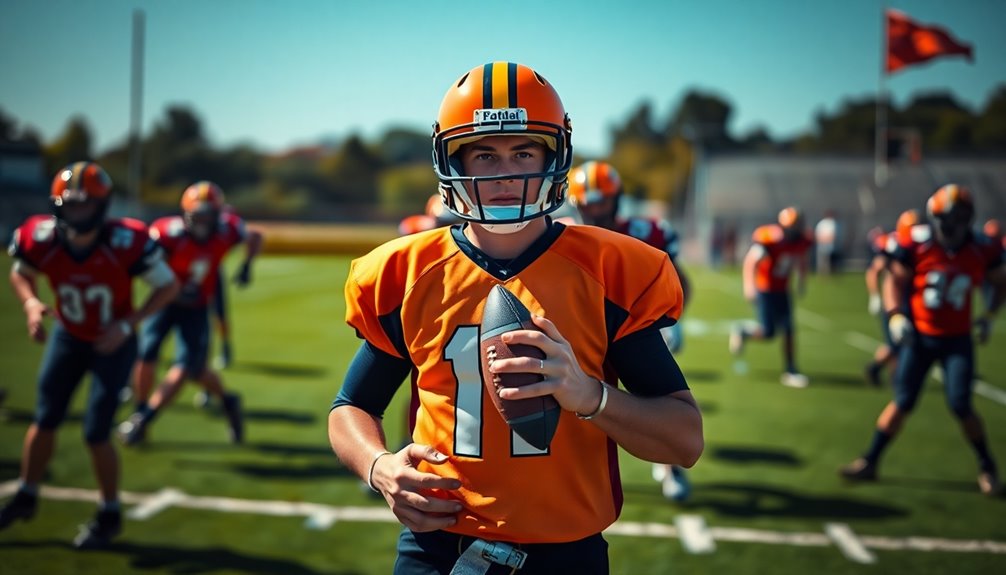
The quarterback holds a pivotal role in flag football, acting as the leader of the offense. As the play begins, you receive the snap from the center and must quickly decide your next move. You can either hand off the ball or throw passes to your teammates, but remember that you can't run with the ball after the snap. This restriction forces you to rely on your decision-making skills within a limited seven-second timeframe. Additionally, practicing passing accuracy can improve your effectiveness in delivering precise throws under pressure. Continuous learning and technical skill mastery can further enhance your capabilities as a quarterback.
Reading the defense is essential; you need to evaluate their formation and determine the best option to advance the ball. Effective communication with your offensive team is critical, as you'll need to relay plays and make adjustments based on how the defense reacts.
A strong arm is necessary for delivering accurate passes, while quick thinking is necessary to maintain offensive momentum. Your success as a quarterback hinges on your awareness and experience. The better you understand the game and your teammates' strengths, the more fluid and effective your offensive strategies will become. Additionally, incorporating data-driven strategies can significantly enhance your decision-making and overall team performance.
Embrace this responsibility, and you'll lead your team toward victory!
The Role of the Center
As the center, you're the unsung hero of the offense, kicking off each play with a precise snap to the quarterback. This initial action is vital since it sets the tone for the entire play.
After the center snaps the ball, your role doesn't end. You can also act as a receiver, providing an unexpected option for the quarterback if the defense is focused elsewhere.
Effective centers have quick reflexes and must be agile and aware of their surroundings. Right after the snap, you're responsible for blocking the pass to protect the quarterback from defenders. This means you need to pivot quickly and position yourself to create separation, making it easier for the quarterback to execute their play. Additionally, utilizing a strong defensive stance can help in maintaining balance while blocking. Speed and agility training can further enhance your ability to react quickly in these situations.
In various offensive schemes, your ability to catch passes or make key blocks often goes unnoticed by the defense, which can turn you into an effective weapon. Additionally, your role as a center is similar to that of a defensive midfielders in soccer, as both positions are crucial for protecting key players and maintaining team structure.
Being versatile and ready to adapt to different situations will help enhance your team's chances of success. So, embrace your role, as the center is indispensable to keeping the offense moving and creating plays.
Wide Receiver Techniques
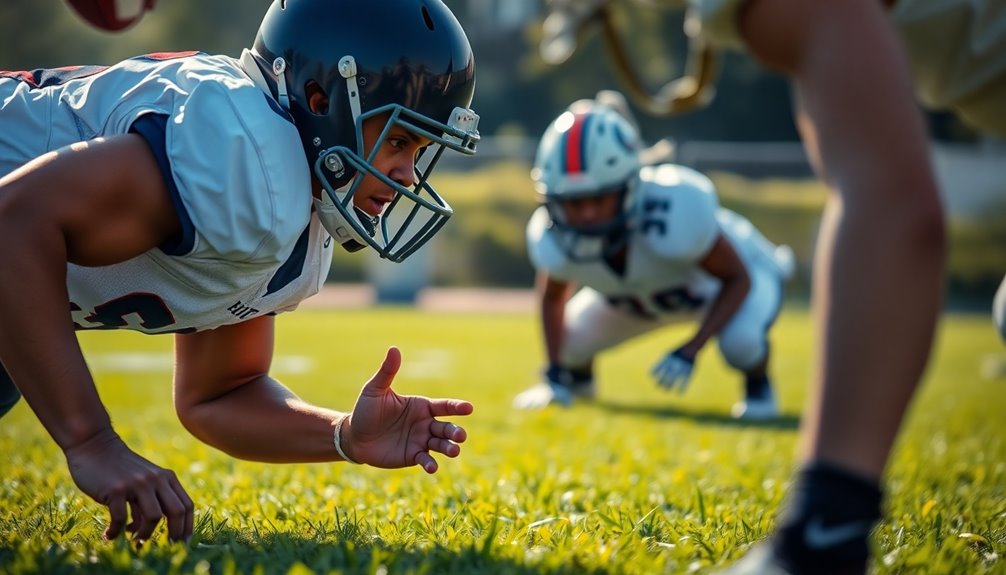
As a wide receiver, mastering route running is vital for getting open and creating plays.
You'll want to focus on catching techniques and tips to secure the ball, while also learning how to evade defenders effectively. Understanding advanced soccer tricks can also enhance your ability to shake off coverage and make big plays. Incorporating techniques like the Cruyff Turn can help you change direction quickly and leave defenders behind. Additionally, employing deceptive moves can further confuse defenders and create separation on the field.
Let's break down these essential skills to elevate your game on the field.
Route Running Fundamentals
In flag football, mastering route running fundamentals is essential for wide receivers to gain separation from defenders and make effective catches. Understanding the various routes like slants, out routes, and go routes is vital.
Here are some key techniques to improve your route running:
- Quick Footwork: Develop agility and speed through drills that enhance your footwork, allowing you to make sharp cuts and evade defensive coverage.
- Timing with the Quarterback: Pay attention to the quarterback's drop back. Knowing when to break off your route can greatly impact your ability to get open.
- Body Positioning: Use your body to shield defenders. Techniques like boxing out can help you create leverage and make it easier to catch the ball.
- Communication: Always stay in sync with your teammates. Adjust your routes based on the defense's alignment and any changes in the offensive strategy during a play.
Catching Techniques and Tips
Effective catching techniques are vital for wide receivers in flag football, directly impacting their ability to make plays. To improve your catching skills, start by using your hands—spread your fingers wide to create a target and guarantee a secure grip on the ball. This helps you catch accurately and reduces the chance of drops.
When running your routes, focus on making quick cuts. Sharp, precise movements will help you create separation from defenders, making it easier for you to receive passes. Maintaining eye contact with the quarterback is important; it allows you to anticipate the throw and prepare to catch effectively.
Practice catching the ball in various positions: high, low, and away from your body. This will enhance your overall catching abilities and build confidence in difficult situations.
Additionally, utilize the diamond technique for high catches. Forming your hands into a diamond shape will improve your catching accuracy and help you secure those challenging passes.
Evading Defenders Strategies
Catching the ball is just the beginning; once you've secured it, your ability to evade defenders becomes vital. To effectively traverse the field and create space, mastering specific techniques is key.
Here are four strategies to enhance your evasion skills:
- Master Your Routes: Learn a variety of routes—like slants, curls, and fades. This variety helps you create separation from defenders and exploit their weaknesses.
- Quick Footwork: Utilize agile footwork to execute moves like "jukes." Changing direction swiftly can mislead defenders, allowing you to gain open space.
- Timing and Communication: Build strong rapport with your quarterback. Precise timing is essential for effective pass-catching, and using body positioning and hand signals can help you adjust based on defensive coverage.
- Acceleration and Deceleration: Practice techniques that allow you to maintain speed while maneuvering through defenders. This helps you evade tackles and make impactful plays.
Running Back Skills
Running backs play an essential role in flag football, as they're often the key to advancing the ball downfield. To excel in this position, you need exceptional agility to navigate through defenders and create opportunities. Mastering the "juke" move will help you fake a direction, misleading defenders and opening up running space.
Quick acceleration is another important trait for running backs. The ability to gain yards swiftly will make it harder for flag pullers to catch you.
In addition, being versatile is critical; you should be capable of both running the ball and catching passes. This versatility enhances your team's offensive strategy, making you a multi-threat player that defenses must account for.
Effective communication with your quarterback is essential for smooth execution during offensive plays. You need to be in sync regarding timing, ensuring you receive handoffs at the right moment.
Defensive Back Functions
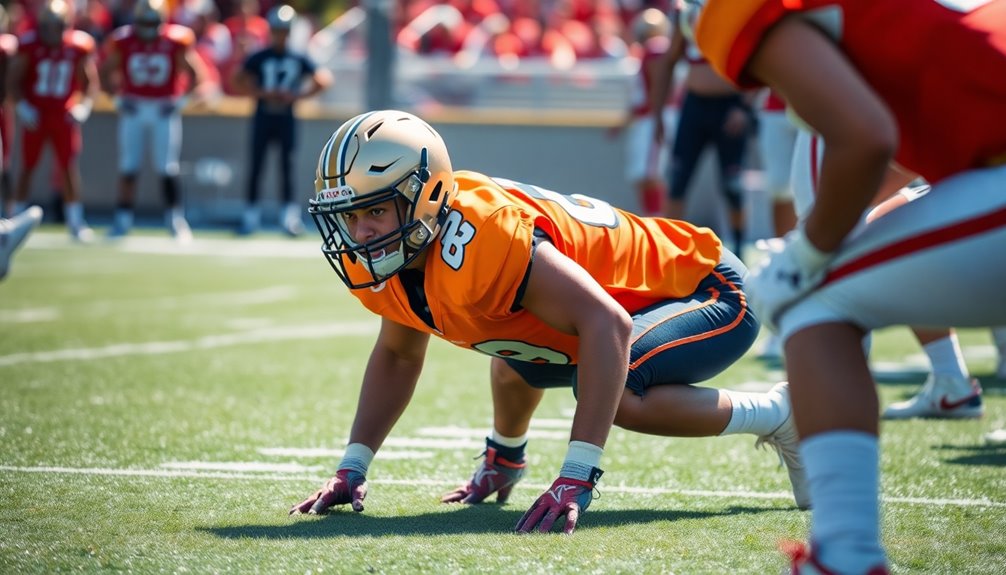
As a defensive back, your main job is to stop the opposing team from making successful plays.
You'll need to master skills like quick footwork and flag-pulling to effectively cover your assignments.
Understanding strategies for interceptions and reading the quarterback are also key to your success on the field.
Key Responsibilities of Defensive Backs
Defensive backs play an essential role in flag football, serving as the last line of defense against offensive plays. They're important in stopping ball carriers and preventing big gains.
Here are some key responsibilities you'll need to focus on:
- Pulling the Flags: Your primary task is to stop ball carriers by pulling their flags. This requires quick reflexes and the ability to anticipate their movements.
- Reading Offensive Plays: You must effectively read the offensive plays to position yourself for potential interceptions or to defend against passes.
- Coverage Strategy: Depending on the offensive formation, you'll need to adapt by playing either man-to-man or zone coverage. Flexibility in your strategy is essential.
- Physical Condition: Staying in excellent physical shape is important. You'll need the stamina and speed to keep up with receivers and react swiftly during plays.
Skills for Effective Coverage
To excel in flag football, mastering skills for effective coverage is key for defensive backs. You need quick feet and agility to anticipate receivers' movements and react promptly to their routes. Being able to read plays is essential, as it positions you effectively to defend against completions or even pull flags from ball carriers. This requires excellent timing and hand-eye coordination.
Effective communication with your teammates is imperative. You'll need to coordinate coverage schemes and switch assignments based on the offensive formation, ensuring everyone is on the same page.
Strong conditioning is equally important, as defensive backs face the demands of sprinting, changing direction, and maintaining coverage throughout the game.
As you hone these skills, focus on improving your agility through drills that enhance your footwork. Work on your timing for pulling flags—practicing with a partner can be particularly useful.
Strategies for Interceptions
Mastering interception strategies is essential for any defensive back who wants to make game-changing plays. To increase your chances of snagging those interceptions, focus on these key strategies:
- Read the Quarterback: Keep your eyes on the quarterback. Anticipating their throws can give you a head start on the play.
- Positioning and Leverage: Maintain proper positioning against the receiver. Use your footwork to stay close without drawing penalties like holding or pass interference.
- Route Awareness: Study the offense's typical route patterns. Understanding their tendencies will improve your ability to predict receiver movements, enhancing your interception chances.
- Effective Communication: Don't underestimate the power of teamwork. Call out coverage assignments and alert your teammates to potential threats, ensuring everyone's on the same page.
Also, developing strong ball skills is vital. When you get your hands on the ball, practice catching and securing it to turn those opportunities into turnovers.
Importance of the Rusher
The rusher plays a pivotal role in flag football, acting as the first line of defense against the quarterback. Starting 7 yards back from the line of scrimmage, you need to apply pressure within a 7-second pass clock. Your speed and athleticism are essential as you quickly close the gap to disrupt the quarterback's ability to throw or hand off the ball.
Strategic timing and positioning are vital. As a rusher, you must anticipate the quarterback's movements, aiming to create a hurried throw or possibly a sack. When you effectively read plays and react quickly, you enhance your team's defensive strategy.
Successful rushing not only pressures the quarterback but can also lead to turnovers. When you force the quarterback to scramble or rush their decision-making, it increases the chance of mistakes, such as an interception or a fumble.
Safety Position Explained
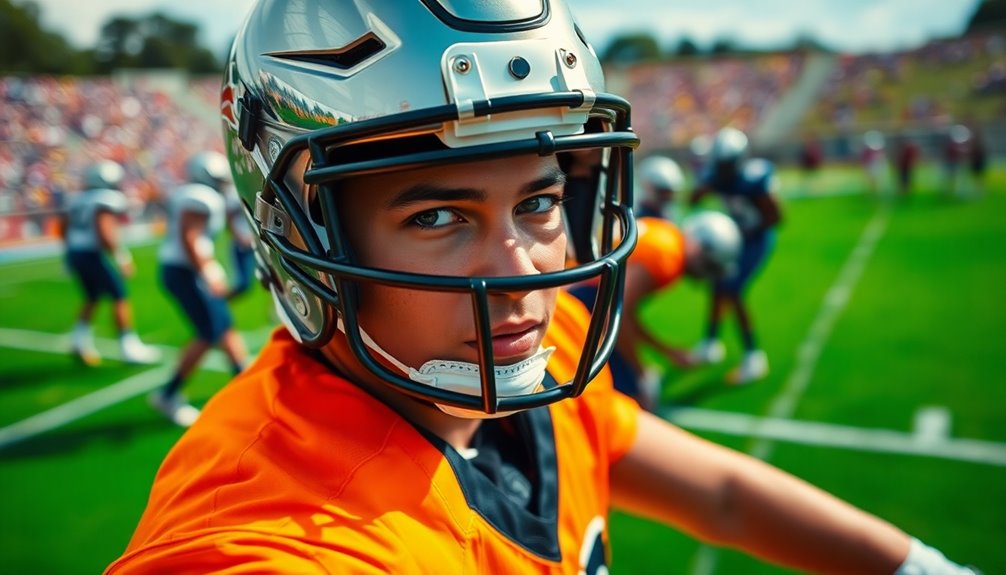
Positioned at the back of the defense, safeties are essential for intercepting passes and thwarting deep plays. Your role as a safety requires strong anticipation skills, enabling you to read the offense and position yourself effectively against threats.
Here are four key responsibilities of a safety:
- Intercepting Passes: You need to track the ball closely, ready to step in and make a game-changing interception.
- Stopping the Ball Carrier: By pulling flags, you can prevent the ball carrier from making long gains or scoring touchdowns.
- Coverage Strategies: You'll work with defensive backs to guarantee proper coverage, switching between man-to-man and zone defense as needed.
- Agility and Speed: Being agile and fast allows you to cover ground quickly, responding effectively to offensive movements.
In flag football, your effectiveness as a safety greatly impacts the overall strength of your defense.
By mastering these aspects, you'll not only protect your team against scoring plays but also contribute to a cohesive defensive strategy.
Embrace your role, and become a key player in stopping the offense!
Teamwork in Flag Football
In flag football, effective communication is essential for your team's success.
Each player needs to understand their roles and responsibilities, ensuring everyone works together seamlessly during plays.
When you collaborate and support one another, you can adapt quickly and exploit your opponents' weaknesses.
Importance of Communication
Effective communication on and off the field is essential for success in flag football. It not only enhances teamwork but also strengthens your ability to execute offensive plays and defensive strategies effectively.
Here are four key aspects of communication that you should prioritize:
- Understanding Roles: Clear communication guarantees every player knows their responsibilities, leading to a more cohesive team effort.
- Anticipating Moves: Good communication helps you and your teammates anticipate opponents' actions, allowing for dynamic adjustments in coverage or rush strategies.
- Using Signals: Practicing verbal signals and non-verbal cues during training fosters a deeper understanding of each other's playing styles, improving overall performance.
- Real-Time Strategy: Regular huddles for discussion enable you to strategize and adapt to the game as it unfolds, promoting collaboration and teamwork.
When you communicate effectively, you build trust among teammates, creating a positive playing environment.
This not only enhances player development but also makes the game more enjoyable for everyone involved.
Prioritize communication, and you'll see how it transforms your team's dynamics on the field.
Roles and Responsibilities
Understanding each player's roles and responsibilities is essential for your flag football team's success. The quarterback leads the offense, making split-second decisions and throwing passes. It's important for you to establish a strong connection with your wide receivers, who run specific routes to create separation from defenders. This teamwork guarantees that your passes are both accurate and timely.
The center plays a unique dual role. Not only do they snap the ball to the quarterback, but they also become an eligible receiver after the snap. Effective communication with the quarterback is critical here.
On the defensive side, defensive players, including defensive backs and rushers, must work together to anticipate offensive plays. By coordinating their movements, they can execute flag pulls more effectively, stopping the opposing team in their tracks.
Key Terms and Concepts
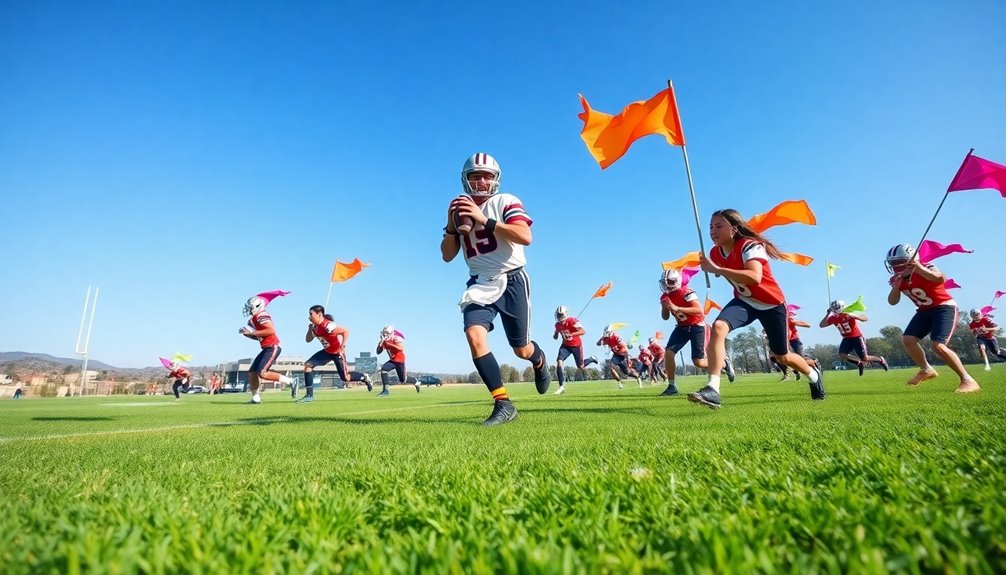
Flag football often features specific terms that are essential for players and fans alike to grasp the game. Understanding these key concepts can enhance your appreciation and performance on the field.
Here are some important terms to know:
- Line of Scrimmage: This imaginary line marks where the play begins. You mustn't cross it until the ball is snapped.
- No Run Zone: In this designated area, the offensive team must pass the ball to earn a first down or score a touchdown. This rule encourages strategic plays and keeps the game exciting.
- Touchdowns: Scoring a touchdown earns your team 6 points. After scoring, you can attempt an extra point conversion, which can be worth either 1 or 2 points, depending on the yard line.
- Blitzing: This defensive tactic allows players to rush the quarterback from a spot 7 yards behind the line of scrimmage after a 7-second count. It adds pressure and challenges the offense.
Basic Rules of the Game
While playing flag football, it's important to know the basic rules that govern the game. This youth sport emphasizes non-contact, meaning tackling, blocking, and diving are prohibited. Instead, players must pull flags to "tackle" an opponent.
Each offense has four downs to advance past midfield, and all passes must be thrown forward and caught beyond the line of scrimmage. The quarterback plays a vital position; they've a seven-second pass clock and can't run with the ball unless they receive a handoff from a teammate.
A play is considered dead when the ball hits the ground, a flag is pulled, or the ball-carrier steps out of bounds.
Scoring in flag football is straightforward: touchdowns are worth 6 points. After scoring, your football team can attempt a 1-point conversion from the 5-yard line or a more challenging 2-point conversion from the 10-yard line.
Understanding these rules for flag football helps you grasp the game's flow and strategies, making it easier for you to enjoy and participate effectively.
Equipment Essentials for Players
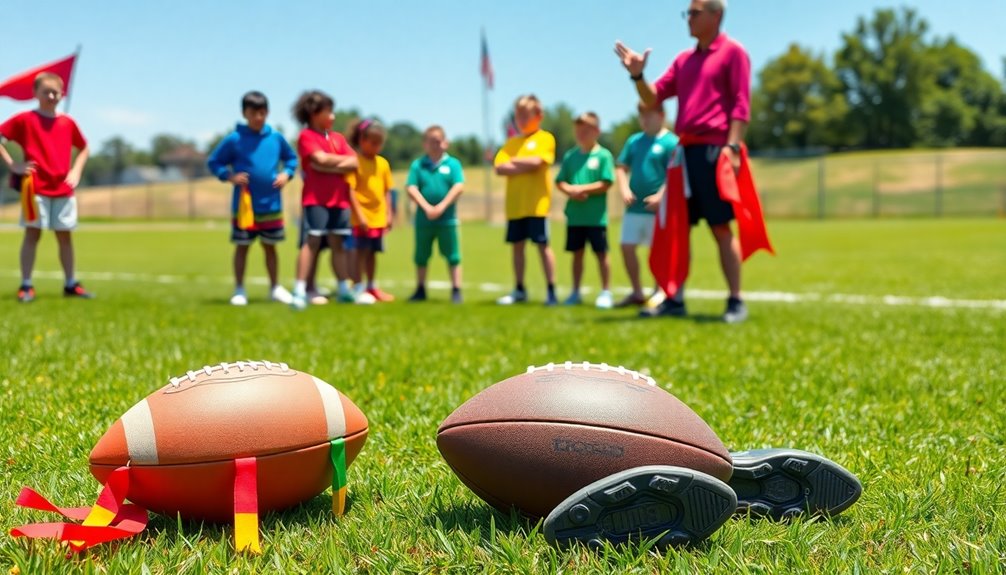
In flag football, having the right equipment is vital for both safety and performance.
You'll need to invest in specific flag football equipment to guarantee you're ready for the game.
Here are four key items every player should have:
- Flags and Belt: Each player must wear flags attached to a belt. These are essential for the flag-pulling mechanism, which is the primary way to "tackle" in the game.
- Pocketless Shorts: It's important to wear pocketless shorts. These prevent penalties and eliminate hazards that could result from pockets during play.
- Mouthguards: Don't forget a mouthguard. This mandatory protective gear helps prevent dental injuries, assuring your safety on the field.
- Cleats: Choose rubber cleats over metal ones. Most leagues prohibit metal cleats to protect players and the playing surface from damage.
Youth Participation in Flag Football
Getting your kids involved in flag football offers them a chance to build essential skills while having fun.
With leagues that welcome both boys and girls, it's a great way to promote inclusivity and guarantee everyone can participate.
Plus, the focus on sportsmanship helps young players not only grow in the game but also in character.
Benefits of Participation
Participating in flag football offers numerous benefits for youth, making it an excellent choice for kids aged 5 to 17. This sport not only promotes fitness but also enhances essential life skills, all while fostering a sense of community.
Here are four key benefits of participation in flag football:
- Improved Fitness: Engaging in flag football boosts cardiovascular health and overall fitness levels, helping kids stay active and healthy.
- Enhanced Skills: The game develops hand-eye coordination and strength through various drills and gameplay, making it fun while improving motor skills.
- Teamwork and Communication: Flag football emphasizes teamwork and effective communication, which are vital for personal development and social interaction among young players.
- Inclusive Environment: The sport welcomes boys and girls of all skill levels, allowing everyone to participate regardless of prior experience, making it accessible and enjoyable for all.
Inclusivity in Leagues
Flag football leagues are designed to be inclusive, allowing kids of all backgrounds and skill levels to join in the fun. These leagues, such as NFL FLAG, cater to boys and girls aged 5 to 17, promoting participation through co-ed options.
This inclusivity guarantees that every youth athlete, regardless of their previous experience or physical build, can engage in the sport and enjoy teamwork and competition.
The growing popularity of flag football among female athletes has led to the emergence of high school and college leagues, further fostering participation. Initiatives like the National Association of Intercollegiate Athletics launching a women's flag football league highlight the commitment to promoting gender equity in sports.
As a parent or guardian, you can feel confident knowing that your child can explore their athletic potential in a supportive environment.
Whether they're just starting or looking to build on existing skills, flag football offers a welcoming space for everyone. Ultimately, these inclusive leagues not only develop essential physical skills but also cultivate camaraderie, making flag football a fantastic choice for youth athletes everywhere.
Skill Development Opportunities
Engagement in youth flag football opens up a world of skill development opportunities that are crucial for both athletic and personal growth. This sport not only promotes fitness but also nurtures significant life skills.
As a participant, you'll enjoy the benefits of structured play that enhances your abilities and prepares you for future challenges.
Here are four key skill development opportunities you can expect:
- Cardiovascular Health: Regular participation improves heart health and stamina, essential for all Youth Sports.
- Hand-Eye Coordination: Catching, throwing, and dodging enhances your coordination, making you a better athlete overall.
- Teamwork: Working with teammates fosters collaboration and communication, qualities that a flag football coach will emphasize throughout practices and games.
- Leadership Skills: Taking on various roles within a team helps develop your leadership abilities, especially as you progress into women's flag football leagues.
With the growing popularity of flag football, especially among female athletes, these opportunities are more accessible than ever.
Coaching Techniques for Beginners
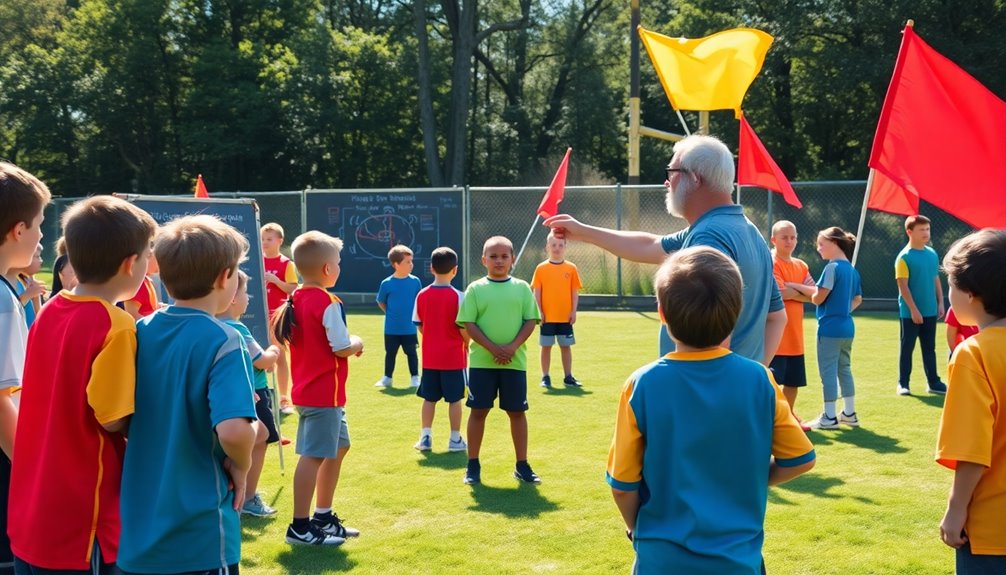
Understanding key positions in flag football is essential for effective coaching, especially for beginners. Start by introducing players to their specific positions early on. This helps them grasp their roles and responsibilities, fostering a sense of ownership and teamwork. Use resources from the official NFL Flag Football site to provide detailed insights about each position, enhancing your coaching strategies.
Focus on skill development by incorporating age-appropriate drills that target fundamental techniques. Tailor these exercises to the specific needs of each position, ensuring players build a solid foundation. During practice sessions, encourage communication and collaboration among players; this builds trust and improves overall team dynamics.
Regular assessments and feedback sessions are vital. They allow you to track player progress and make necessary adjustments to individual and team strategies. By reinforcing key concepts and providing constructive feedback, you'll help players understand the importance of teamwork and communication on the field.
Conclusion
Now that you've explored the key positions in flag football, you're equipped to hit the field with confidence. Think of each player as an essential cog in a well-oiled machine; together, you create a dynamic force. Whether you're tossing the ball, snapping it, or sprinting for a catch, remember that teamwork is your secret weapon. So lace up your cleats, relish the game, and let the thrill of competition fuel your passion for flag football!


